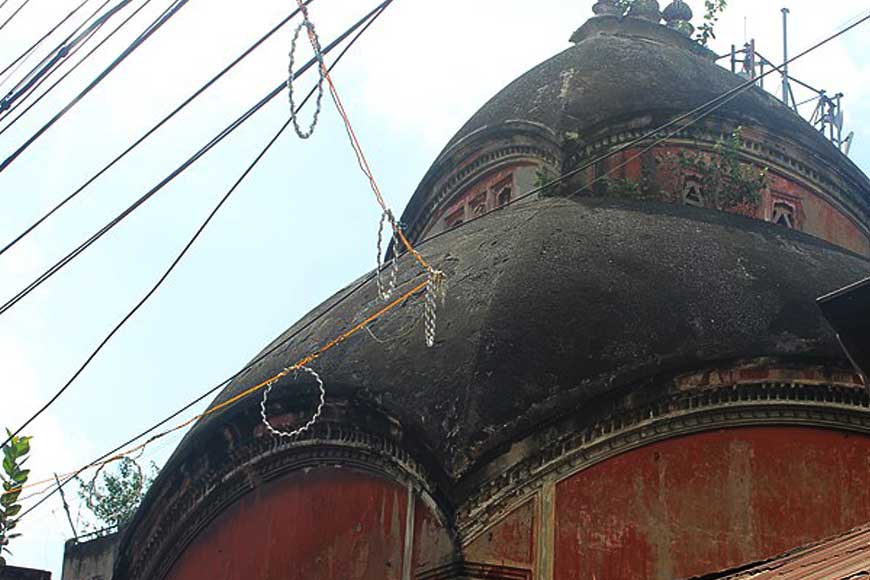Lost in obscurity, Calcutta’s oldest surviving temples

Rameswar Shiva Temple
Last week, we left off at the Siddheswari Kali Temple, on Madanmohantala Street near the Shyambazar crossing. Just ahead of this small street, which borders the eastern end of Bagbazar, lies Girish Avenue. The Madanmohan Temple we visited last week is on the cusp of Madanmhonatala Street and Chitpur Road, where the Siddheswari Temple stands. We need to take in a couple of more temples on this week’s journey, after which, as we mentioned last week, we will strike out in an entirely different direction.
Opposite the Siddheswari Temple is a small complex of more recent temples, including one dedicated to Hanuman, another to Ratneswar, a form of Lord Shiva. Behind this is the temple we’d like you to look at.
Point A - Gopeswar Shiva Temple
Behind the Ratneswar temple, you will see a much older, ‘aatchala’ style structure, a Shiva temple dedicated to the deity in his Gopeswar avatar. The modest looking building is nonetheless distinguished by a quite high ceiling, though this is not the primary reason that it is of interest to us. What does interest us is that several chroniclers of old Kolkata have said that this temple could quite possibly be the original and famous ‘Black Pagoda’ built by Gobindaram Mitra, the notorious ‘black zamindar’ of 18th-century Calcutta.
From all accounts, the entrance to this temple used to be from the west, with the river Hooghly flowing almost directly alongside it. The course of the river has now shifted about 100 m to the west, but if the famous prints of Thomas Daniell are any indication, it does appear as though this temple was either the Black Pagoda, or a replacement which came up after the devastating cyclone of 1737.
Point B - Shyamsundar and Buro Shib Temples
Walking a little further along Chitpur Road, turn right into Kumortuli, the renowned and much-photographed neighbourhood of potters (‘kumor’ in Bengali and ‘kumhar’ in Hindi) responsible for producing nearly all of the state’s clay idols of deities and even its secular human figures!
At the western border of Kumortuli lies Banamali Sircar Lane, named after the man who, in 1750 or thereabouts, built the Shyamsundar Temple which still stands at one end of the lane. The low, flat-roofed structure is adorned by quite a few pillars, and is dedicated to Lord Krishna. Even today, the temple priests traditionally belong to a community from Patrasayar in Bankura, bearing the title of Nayak.
Read the earlier episodes of our walk :
Enjoy the lockdown with your very own customised Kolkata Walk
A little bit of BBD Bag, a whole lot of Calcutta
Esplanade, the beating heart of old Calcutta
The places of worship in old Calcutta, and what we learn from them
Walk on for a perfect balance of religion and commerce
On the waterfront: a walk along the Hooghly
Walking around the ‘native’ palaces of Kolkata
A walk down Sealdah and Bowbazar, among the oldest areas of Kolkata
Walking through the centre of Kolkata
Old Calcutta’s temple trail, a cultural odyssey

But even more interesting is the very old Shiva temple which stands on a very narrow alley off Banamali Sircar Lane, known locally as the Buro Shib Mandir. From all appearances, this ‘aatchala’ style structure is Kolkata’s only surviving terracotta temple, complete with terracotta tablets on the frieze just below the roof. The style seems to date back to a period of nearly 350 years ago, though no proper documentation of the temple’s age is available in the public domain. Also sadly, many of the terracotta tablets were taken off and away during the politically turbulent 1970s.
Point C - Rameswar Temple
Still sticking to Chitpur Road, walk in the direction of Sovabazar Street until you come to Nandaram Sen Street. Turn into it and walk past sundry shops and houses until you spot the nearly 40-foot high spire of the Rameswar Shiva Temple. An inscription claims the temple was built by Nandaram Sen, and the date of the inscription is given as 31 Chaitra, 1061 according to the Bengali calendar, the corresponding Gregorian calendar month and year being April 1665. That would make it one of Kolkata’s oldest surviving temples, in the same league as the Chitteswari Temple, built in 1610 by Manohar Ghosh. The Nandaram Sen in question would be the Dewan of the British Resident in Dhaka, and later the deputy to Governor Robert Sheldon in 1700. However, some researchers have contested this identity and claimed that Nandaram was actually a wealthy trader who lived in the city in the early 1800s, which would make the temple considerably less ancient.
Having taken longish walks for two weeks, we will end the temple trail here. Next week, we will visit temples of a different sort, those dedicated to knowledge and education. Until then, keep walking.










